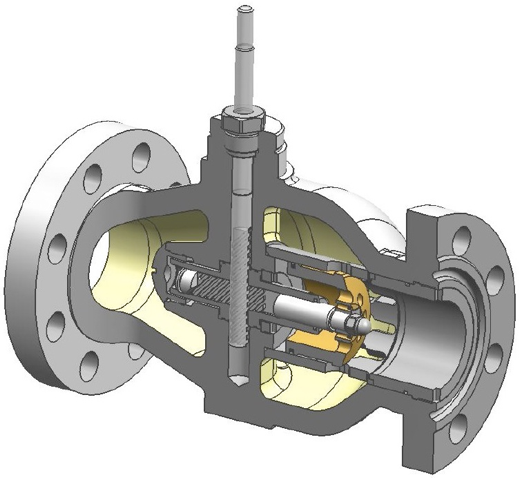Introduction
The axial valves find a use in many fields associated with transmission of gases and liquids. They are used in gas transporting and gas production systems, at refineries, trunk pipelines, and in many other spheres.
The construction of axial type is characterized with compact size and provides big transmission capacity, low noise and turbulence level, prevents erosion.

Fig. 1 – Rack-and-pinion drive mechanism of the axial type valve
However, the valve construction has certain trouble spots relating to mobile mate parts friction, which in significant degree defines efficiency and operating properties of the item.
This task can be solved by using the solid lubrication technology.
The basic elements of the axial type valve are the following: an outer case, an inner case, a piston, a piston rod, a valve spindle rod, and a separator. The outer and inner cases are as a rule a single cast part.
The piston moves along the valve axially through the gear transmission consisting of two helical racks located at right angles which are a piston rod, and a valve spindle, accordingly. The elements of the gear transmission are made with high accuracy and provide a minimum gap.
The essential fault of such solution is increased friction losses since the racks operate in sliding mode at high loads. It demands an increased effort from the drive side. While the mechanism operation, the friction forces can be such strong that they lead to significant elastic deformation of the racks with the risk of transmission jamming to occur. At cycling operation, wear and irreversible changes in quality of the friction surfaces occur, and there are increased probability of seizure and jamming.
The rack-and-pinion gear operates under conditions of high contact pressures and of slow motion speeds. In such situation any lubricant is squeezed out of the contact zone, and thus forms only a thin boundary film which is not effective enough.
Application of the solid lubrication technology is optimal here for solving the task of reducing friction
The technology was created specifically for operating under extreme conditions when conventional oils and greases are not effective.

Solid lubricating materials operate at temperatures -200°С to +600°С

At contact pressures up to 2500 MPa

They demonstrate low friction coefficient down to 0.03 at slow sliding up to 0.5 m/s

The solid lubrication technology can be realized by applying the anti-friction coatings onto the parts
What are Anti-Friction Solid-Film Coatings (ASCs)?

Fig. 2
Fig. 3
The Anti-Friction Solid-Film Coatings (ASC) technology enables to form a thin 5 to 20 µm thick composite layer on the part surface. This layer is a polymer matrix firmly bonded to the base, while its cells are filled up with the ultrafine particles of the solid lubricating material (see Figures 2, 3). The coating has high compression strength and low shear strength. As a result, the dry friction coefficient reaches the values of a few hundredths at the contact pressures which are commensurable with the flow limit of the material of the base.
Modengy Russian company has developed Anti-Friction Solid-Film Coatings for the parts of the rack-and-pinion gear
These coatings have successfully received approval, and provide three to five times friction reduction, and the corresponding increase of the unit service life. The typical Anti-Friction Solid-Film Coatings performances are given in Table 1 below.
The coatings are to be applied just once, and they keep operating during the entire service life term of the item providing necessary surface lubrication and protection.

The Anti-Friction Solid-Film Coatings are applied by spraying out the liquid agent onto preliminary prepared surface

The coating gets cured and tack free within 10 minutes, and then the part can be safely transported without any risk of being disrupted or damaged

Full curing of the Anti-Friction Solid-Film Coatings occurs after exposure at the certain temperature (+130°С to +200 °С, it takes 40 to 70 minutes)
Table 1. Anti-Friction Solid-Film Coatings composition and features
| MODENGY Anti-Friction Solid-Film Coating product | Solid lubricating component | Service temperature range, °С | Load carrying capacity acc. to ASTM D2626, N | Wear resistance acc. to ASTM D2714, thousand cycles |
Friction coefficient acc. to ASTM D2714 |
Corrosion protection acc. to ISO R 1456 (test in salt mist), hours |
|---|---|---|---|---|---|---|
|
1005 |
Molybdenum disulfide, graphite | -200...+255 | 15000 | 280 | 0,03 | - |
| 1004 |
Molybdenum disulfide |
-200...+440 | 16000 | 50 | 0,03 | 500 |

Fig. 4 – The parts of the rack-and-pinion valve covered with MODENGY coating
Modengy 1005 is characterized by significantly higher wear resistance in comparison with Modengy 1004 (see Table 1). The main advantage of Modengy 1004 is high anticorrosion properties, and the fact that this coating can be used for not corrosion resistant materials providing them protection and lubrication they need. On Figure 4 you can see the photo of the parts of the rack-and-pinion gear valve covered with Modengy 1004.
The Modengy Anti-Friction Solid-Film Coatings technology provides the surface with the necessary set of tribotechnical and protective properties at operating under extreme conditions
Application of this technology enables to control friction effectively, and thus, to extend service life and improve energy efficiency of the axial valves. Modengy Anti-Friction Solid-Film Coatings are used at manufacturing the pipeline fittings and spare parts for it in complying with the import substitution program.
Submit a request for more detailed information about Anti-Friction Solid-Film Coatings (ASC) technology
Request Information




 RU
RU
 EN
EN





